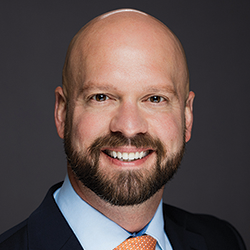
Voice of the President | May 2023

One night early in my career, I arrived to work and learned a nurse colleague had taken her life. I had just worked alongside her the week prior as we shared a hall of patients for a couple of consecutive nights. How could this be?
That somber night occurred more than 20 years ago, and I can still remember my gut-wrenching feeling every time I hear that a health care worker’s life ended by suicide. In 2016, the Centers for Disease Control and Prevention identified health care workers in the top five for occupational suicide rates for women and top ten for men. In 2018, the National Academy of Medicine acknowledged that burnout, depression and suicide in nursing are a significant threat to our health care system. However, because these instances are not consistently reported, accurate data are unavailable.
Talking about mental health can be uncomfortable, some may even say hard. Because of the long-held stigma associated with mental health issues, it can be even more challenging to approach the topic in the workplace. Clinicians can struggle with processing feelings and have an even harder time discussing their emotions.
As nurses, we have been trained to holistically care for others. We see patients during some of the most vulnerable times of their lives and witness events that change their lives. On the good days, we see joy and the happy tears celebrating life. On the bad days, we see trauma, grief and tears filled with sadness and pain.
Learning to process these emotions is complex. There is no secret recipe or one-size-fits-all solution to implement. Just as each of us has unique fingerprints, so too do we have unique emotional and psychological needs. With experience, training and practice many nurses learn how to effectively cope with the highs and lows that come with our profession. Unfortunately, many nurses don’t have healthy strategies to effectively cope. Instead, they suppress emotion, lose sleep, become cynical or worse, explore other unhealthy ways such as using drugs or alcohol to numb the pain.
During the height of the COVID-19 pandemic in September 2020, Mental Health America conducted a national survey of health care workers. It revealed 82% were experiencing mental exhaustion, followed by 70% having trouble sleeping; 68% were physically exhausted and 63% experienced work-related dread. Over half (55%) were questioning their career paths and experiencing compassion fatigue (52%).
In August 2022 AONL completed the fourth edition of the COVID-19 Longitudinal Study. For the first time, the emotional health and well-being of staff rose as the number one concern of nurse leaders, with nearly 75% identifying it in their top three challenges. That same study asked nurse leaders how effective they were at supporting the emotional health and well-being of staff. Nearly seven out of ten nurse leaders identified their effectiveness as neutral, poor or very poor.
COVID-19 brought to light the depth and breadth of behavioral health needs across the United States. As the CNO of Norton Children’s Hospital, Louisville, Ky., I saw patient admissions with behavioral health diagnoses increase fourfold. Patients and families struggled to gain access to services. Multiple pediatric organizations and professional associations, including the American Academy of Pediatrics, declared a behavioral health state of emergency for children and adolescents.
The prevalence isn’t exclusive to pediatric patients. According to the Substance Abuse and Mental Health Services Administration, one in five adults in America experience mental health illness each year and one in 20 experience severe mental illness. Of all the statistics I’ve seen recently, the most powerful came from the CDC which identified suicide as a leading cause of death for individuals 5 to 65 years old. In addition, suicide is one of the top 10 causes of death for children 1 to 19 years of age.
Most months I aim to inspire and uplift our members in my column and highlight the joy that comes with nursing leadership. This month I aim to ignite a fire and create a burning platform where we, all 11,000+ members, can align with AONL’s vision to unite as one voice advancing health for all.
We need action and advocacy to create policy to support state and federal funding for behavioral health program development and expansion. Hospitals and health systems need to dedicate resources toward programs and interventions that support health care workers and patients alike. Universities and schools of nursing can embed self-care, compassion fatigue and suicide prevention training into curricula. Many state boards of nursing are now requiring nurses to complete continuing education on behavioral health and suicide prevention.
Each of us can and should lead by example to embrace and promote self-care, work-life balance and making our mental health a priority. NAM has developed a national plan for workforce well-being, outlining actions to take to safeguard our health care teams. The American Hospital Association also has resources for health care organizations seeking to support their workforces at aha.org/suicideprevention/health-care-workforce.
In this month’s edition of Voice you’re going to hear from nurse leaders who are confronting challenges related to behavioral health head-on – and finding solutions. These are but a few of the shining examples.
Erasing the stigma around behavioral health won’t happen overnight, but it starts with dialogue.
This is a topic that deserves our time and attention. Erasing the stigma around behavioral health won’t happen overnight, but it starts with dialogue. Who better to start the conversation and keep it going than nurse leaders?


